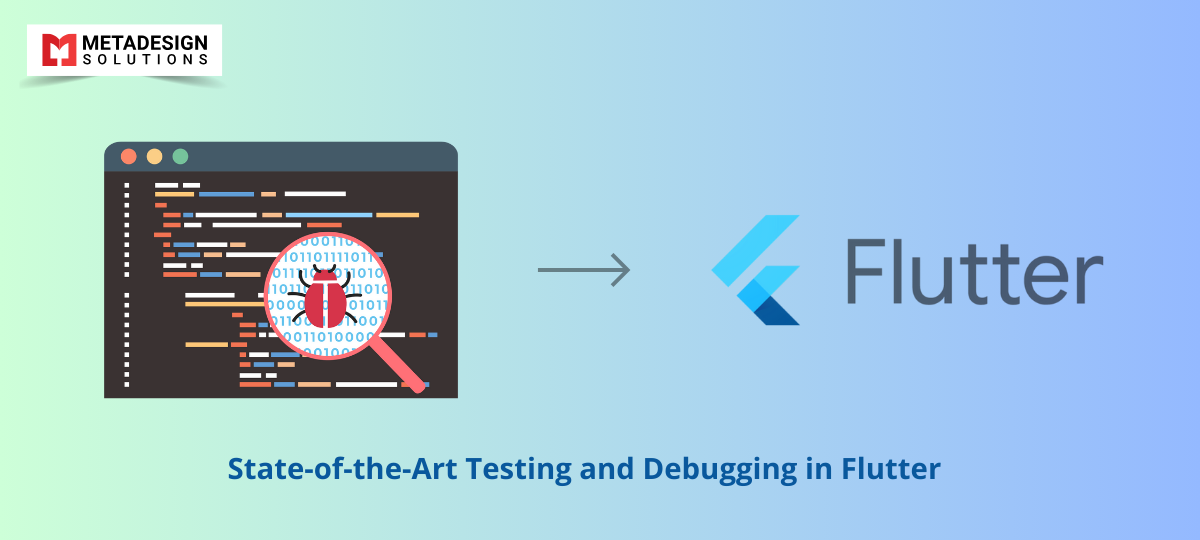As someone who has been deeply involved in Flutter development at MetaDesign Solutions, I understand the critical importance of robust testing and effective debugging. Ensuring your Flutter application is reliable and bug-free is essential for delivering a high-quality user experience.
In this blog, I’ll explore advanced testing techniques and debugging tools in Flutter that can help you maintain code quality and streamline the development process.
The Importance of Testing in Flutter
Testing verifies that your code works as intended and helps catch issues early in the development cycle. Flutter provides a comprehensive testing framework that supports:
- Unit Tests: Test individual functions or classes.
- Widget Tests: Test UI components in isolation.
- Integration Tests: Test the complete app or large parts of it.
Writing Effective Unit Tests
Unit tests focus on the smallest pieces of code, ensuring that individual functions behave correctly.
Example: Testing a simple calculator function.
dart code:
// calculator.dart
int add(int a, int b) => a + b;
// calculator_test.dart
import 'package:flutter_test/flutter_test.dart';
import 'calculator.dart';
void main() {
test('adds two numbers', () {
expect(add(2, 3), 5);
});
}
Best Practices:
- Isolate Dependencies: Mock external dependencies using packages like mockito.
- Name Tests Clearly: Use descriptive names to indicate what the test verifies.
- Keep Tests Small: Focus on one aspect of functionality per test.
Widget Testing for UI Components
Widget tests verify the behavior of UI elements without the need to run the app on a device or emulator.
Example: Testing a Counter widget.
dart code:
// counter_widget_test.dart
import 'package:flutter_test/flutter_test.dart';
import 'package:flutter/material.dart';
import 'counter.dart';
void main() {
testWidgets('Counter increments smoke test', (WidgetTester tester) async {
await tester.pumpWidget(CounterApp());
// Verify initial value is 0
expect(find.text('0'), findsOneWidget);
expect(find.text('1'), findsNothing);
// Tap the '+' icon and trigger a frame
await tester.tap(find.byIcon(Icons.add));
await tester.pump();
// Verify value increments to 1
expect(find.text('0'), findsNothing);
expect(find.text('1'), findsOneWidget);
});
}
Optimize Your App for Diverse Audiences
Adapt your Flutter app to various languages and cultural norms. Contact us to discuss tailored solutions for seamless localization and internationalization.
Tips:
- Use pumpWidget(): Loads the widget into the test environment.
- Leverage Finders: Use find.byType, find.byKey, or find.text to locate widgets.
- Simulate User Actions: Use tester.tap(), tester.enterText(), etc.
Integration Testing for Full App Flow
Integration tests run the app on a real or virtual device, testing complete scenarios.
Setup:
Create Test Directory:
bash code:
mkdir integration_test
Write an Integration Test:
dart code:
// integration_test/app_test.dart
import 'package:flutter_test/flutter_test.dart';
import 'package:integration_test/integration_test.dart';
import 'package:your_app/main.dart' as app;
void main() {
IntegrationTestWidgetsFlutterBinding.ensureInitialized();
testWidgets('full app test', (WidgetTester tester) async {
app.main();
await tester.pumpAndSettle();
// Interact with the app
await tester.tap(find.byIcon(Icons.add));
await tester.pumpAndSettle();
expect(find.text('1'), findsOneWidget);
});
}
Run the Test:
bash code:
flutter drive --driver=test_driver/integration_test.dart --target=integration_test/app_test.dart
Best Practices:
- Use Real Devices: Integration tests can be more reliable on actual hardware.
- Automate Testing: Integrate tests into your CI/CD pipeline.
Advanced Debugging Techniques
Debugging is essential for identifying and fixing issues quickly.
Flutter DevTools
An extensive suite of performance and debugging tools.
- Widget Inspector: Visualize and explore the widget tree.
- Timeline View: Analyze app performance and frame rendering.
- Memory View: Monitor memory usage and identify leaks.
Usage:
- Run your app in debug mode.
Open DevTools via the command line:
bash code:
flutter pub global activate devtools
flutter pub global run devtools
Logging and Error Handling
- Print Statements: Use print() or debugPrint() for simple logging.
- Logging Packages: Use packages like logger for more advanced logging features.
- Error Widgets: Implement ErrorWidget.builder to customize error displays.
Example:
dart code:
ErrorWidget.builder = (FlutterErrorDetails details) {
return Center(
child: Text(
'An error occurred!',
style: TextStyle(color: Colors.red),
),
);
};
Analyzing Stack Traces
When exceptions occur, Flutter provides stack traces to help locate the issue.
- Read from Bottom Up: The most relevant information is usually at the bottom.
- Look for Your Code: Identify where in your code the error originated.
Using Breakpoints
Set breakpoints in your IDE (e.g., Visual Studio Code or Android Studio) to pause execution and inspect variables.
- Conditional Breakpoints: Pause only when certain conditions are met.
- Watch Expressions: Monitor specific variables during runtime.
Continuous Testing with CI/CD
Integrate testing into your continuous integration pipeline to catch issues early.
- Tools: Use services like GitHub Actions, Jenkins, or GitLab CI/CD.
- Automated Testing: Run tests automatically on each commit or pull request.
- Reporting: Generate test reports and notifications for failed tests.
Example GitHub Actions Workflow:
yaml code:
name: Flutter CI
on: [push, pull_request]
jobs:
build:
runs-on: ubuntu-latest
steps:
- uses: actions/checkout@v2
- uses: subosito/flutter-action@v2
with:
flutter-version: 'stable'
- run: flutter pub get
- run: flutter test
How MetaDesign Solutions Ensures Quality
At MetaDesign Solutions, we prioritize code quality and reliability.
Our Approach:
- Test-Driven Development (TDD): Writing tests before code to define desired behavior.
- Code Reviews: Peer reviews to maintain high standards.
- Automated Testing: Comprehensive test suites integrated into CI pipelines.
- Continuous Monitoring: Using tools to monitor app performance post-deployment.
Success Story:
We developed a healthcare app requiring high reliability. By implementing rigorous testing and debugging practices, we achieved zero critical bugs in production, enhancing user trust and satisfaction.
Get in Touch
Ensuring your Flutter app is robust and error-free is crucial for success. Let us help you implement state-of-the-art testing and debugging practices.
Contact us at sales@metadesignsolutions.com to discuss your project.
Related Keyphrase:
#Flutter #FlutterTesting #MobileAppTesting #FlutterDev #AppDebugging #FlutterDebugging #TestDrivenDevelopment #FlutterAppDevelopment #MobileAppDevelopment #FlutterUI #AppTesting #DebuggingInFlutter #FlutterTips #CrossPlatformDevelopment #MobileDev #AppDevelopment #FlutterCommunity #FlutterApps #UnitTesting #IntegrationTesting #FlutterDeveloper #TestAutomation #AppPerformance #MobileAppDebugging #FlutterTestingTools



